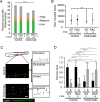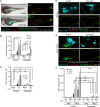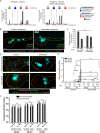Redundant Trojan horse and endothelial-circulatory mechanisms for host-mediated spread of Candida albicans yeast
- PMID: 32776983
- PMCID: PMC7447064
- DOI: 10.1371/journal.ppat.1008414
Redundant Trojan horse and endothelial-circulatory mechanisms for host-mediated spread of Candida albicans yeast
Abstract
The host innate immune system has developed elegant processes for the detection and clearance of invasive fungal pathogens. These strategies may also aid in the spread of pathogens in vivo, although technical limitations have previously hindered our ability to view the host innate immune and endothelial cells to probe their roles in spreading disease. Here, we have leveraged zebrafish larvae as a model to view the interactions of these host processes with the fungal pathogen Candida albicans in vivo. We examined three potential host-mediated mechanisms of fungal spread: movement inside phagocytes in a "Trojan Horse" mechanism, inflammation-assisted spread, and endothelial barrier passage. Utilizing both chemical and genetic tools, we systematically tested the loss of neutrophils and macrophages and the loss of blood flow on yeast cell spread. Both neutrophils and macrophages respond to yeast-locked and wild type C. albicans in our model and time-lapse imaging revealed that macrophages can support yeast spread in a "Trojan Horse" mechanism. Surprisingly, loss of immune cells or inflammation does not alter dissemination dynamics. On the other hand, when blood flow is blocked, yeast can cross into blood vessels but they are limited in how far they travel. Blockade of both phagocytes and circulation reduces rates of dissemination and significantly limits the distance of fungal spread from the infection site. Together, this data suggests a redundant two-step process whereby (1) yeast cross the endothelium inside phagocytes or via direct uptake, and then (2) they utilize blood flow or phagocytes to travel to distant sites.
Conflict of interest statement
The authors have declared that no competing interests exist.
Figures







Similar articles
-
Prescription of Controlled Substances: Benefits and Risks.2025 Jul 6. In: StatPearls [Internet]. Treasure Island (FL): StatPearls Publishing; 2025 Jan–. 2025 Jul 6. In: StatPearls [Internet]. Treasure Island (FL): StatPearls Publishing; 2025 Jan–. PMID: 30726003 Free Books & Documents.
-
Candida albicans Goliath cells pioneer biofilm formation.mBio. 2025 Aug 8:e0342524. doi: 10.1128/mbio.03425-24. Online ahead of print. mBio. 2025. PMID: 40778760
-
Short-Term Memory Impairment.2024 Jun 8. In: StatPearls [Internet]. Treasure Island (FL): StatPearls Publishing; 2025 Jan–. 2024 Jun 8. In: StatPearls [Internet]. Treasure Island (FL): StatPearls Publishing; 2025 Jan–. PMID: 31424720 Free Books & Documents.
-
How lived experiences of illness trajectories, burdens of treatment, and social inequalities shape service user and caregiver participation in health and social care: a theory-informed qualitative evidence synthesis.Health Soc Care Deliv Res. 2025 Jun;13(24):1-120. doi: 10.3310/HGTQ8159. Health Soc Care Deliv Res. 2025. PMID: 40548558
-
The Black Book of Psychotropic Dosing and Monitoring.Psychopharmacol Bull. 2024 Jul 8;54(3):8-59. Psychopharmacol Bull. 2024. PMID: 38993656 Free PMC article. Review.
Cited by
-
Candida albicans and Candida glabrata: global priority pathogens.Microbiol Mol Biol Rev. 2024 Jun 27;88(2):e0002123. doi: 10.1128/mmbr.00021-23. Epub 2024 Jun 4. Microbiol Mol Biol Rev. 2024. PMID: 38832801 Free PMC article. Review.
-
Host immune responses in the central nervous system during fungal infections.Immunol Rev. 2022 Oct;311(1):50-74. doi: 10.1111/imr.13101. Epub 2022 Jun 7. Immunol Rev. 2022. PMID: 35672656 Free PMC article. Review.
-
Hiding in the yolk: A unique feature of Legionella pneumophila infection of zebrafish.PLoS Pathog. 2023 May 8;19(5):e1011375. doi: 10.1371/journal.ppat.1011375. eCollection 2023 May. PLoS Pathog. 2023. PMID: 37155695 Free PMC article.
-
Forward genetic screen in zebrafish identifies new fungal regulators that limit host-protective Candida-innate immune interaction.bioRxiv [Preprint]. 2025 Feb 15:2025.02.14.638315. doi: 10.1101/2025.02.14.638315. bioRxiv. 2025. Update in: mBio. 2025 May 14;16(5):e0052925. doi: 10.1128/mbio.00529-25. PMID: 39990375 Free PMC article. Updated. Preprint.
-
Forward genetic screen in zebrafish identifies new fungal regulators that limit host-protective Candida-innate immune interaction.mBio. 2025 May 14;16(5):e0052925. doi: 10.1128/mbio.00529-25. Epub 2025 Apr 2. mBio. 2025. PMID: 40172223 Free PMC article.
References
Publication types
MeSH terms
Grants and funding
LinkOut - more resources
Full Text Sources
Medical
Molecular Biology Databases

